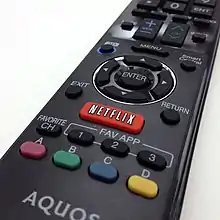Netflix button
The Netflix button is a button available on many modern remote controllers, used to directly connect to the popular streaming service Netflix. It was initially implemented in America in 2011.[1] In 2015, the button was added to European remotes.[2] This button sends an infrared (IR) signal to the television and opens up the Netflix app. Many popular TV companies have adopted the Netflix button, including: LG, Samsung, Sony, and Hisense. Some of the TVs have made it to a list that Netflix has dubbed the "Netflix Recommended TVs". These are TVs that have a Netflix button on them which Netflix recommends to their subscribers to get the best viewing experience for their service.[3]
The Netflix button only works on those TVs that support it, this includes: "Smart TVs, game consoles, streaming media players, set-top boxes, and Blu-ray players".[4] Although hard-programmed on many devices, the Netflix button as of recent has been opening up to re-purposing. On the NVIDIA Shield, the remote has a Netflix button that can be reprogrammed very easily using a program on the device.[5]

Netflix, in 2015, had also open-sourced a design for consumers to create their own Netflix button with additional features.[6] Labeled "The Switch", this homemade device can dim the lights, silence incoming phone calls, order take-out, and open Netflix with one button press. The Switch is part of a series of DIY projects Netflix created, knows as "Netflix Make It" for their consumers to learn more about programming and create their own projects.
The introduction of the Netflix button was criticized; an article from "The Verge" says that the button comes as a constant advertisement on a device you had already paid up to thousands of dollars for. Arguing that the buttons are "putting making money ahead of actual user experience or design".[7] Initially, concerns had been raised about whether the button violates the principle of net neutrality, by putting its streaming competitors in disadvantage.[8] A common complaint is that someone who is not a Netflix subscriber who accidentally presses the Netflix button is taken to a useless screen.
A popular option for streaming services, Roku, has 4 separate streaming buttons on their remotes. Each of these buttons cost the streaming service one dollar per unit sold.[9] The Roku has many different buttons for the consumer to choose, but most of the remotes feature a Netflix button on them.
Other streaming services and media, such as Hulu, Amazon Prime Video, Samsung TV Plus, Spotify, Crunchyroll, YouTube, and Disney+, also have their own buttons.[10]
References
- Yarow, Jay. "Netflix Partnering With Major TV Makers To Add A Netflix Button To TV Remotes". Business Insider. Retrieved 2020-04-23.
- "Netflix is about to get much easier to use". The Independent. 2015-04-02. Archived from the original on 2022-06-18. Retrieved 2020-04-30.
- "Netflix Recommended TVs | Built for a better Netflix experience". devices.netflix.com. Retrieved 2015-05-01.
- "How can I watch Netflix on my TV?". Help Center. Retrieved 2020-05-01.
- "Here's how to repurpose the Netflix button on the new Shield TV remote". Android Police. 2019-10-31. Retrieved 2020-04-23.
- "Personal Trainer | Make It by Netflix". makeit.netflix.io. Archived from the original on 2017-03-21. Retrieved 2015-05-01.
- Gartenberg, Chaim (2020-04-24). "The Netflix button is an advertisement masquerading as a product". The Verge. Retrieved 2020-04-28.
- Effros, Steve (5 January 2011). "The "Netflix Button" Violates "Net Neutrality"". digitalsociety.org. Archived from the original on 9 January 2011. Retrieved 26 October 2021.
- Bouma, Luke (2019-12-12). "Roku Charges $1 Million For Home Page Takeovers, & Branded Remote Buttons Go For $1 Per Customer". Cord Cutters News. Retrieved 2020-04-28.
- Pocket-lint (2020-09-11). "PS5 Media Remote to get Netflix, Disney+ and Spotify buttons". www.pocket-lint.com. Retrieved 2021-04-15.